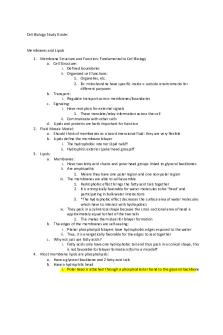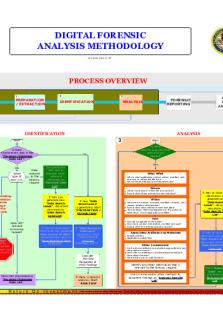MED3ABS Forensics Biology Lecture Guide PDF

| Title | MED3ABS Forensics Biology Lecture Guide |
|---|---|
| Course | Applications Of Biomedical Science |
| Institution | La Trobe University |
| Pages | 3 |
| File Size | 110.1 KB |
| File Type | |
| Total Downloads | 79 |
| Total Views | 128 |
Summary
Download MED3ABS Forensics Biology Lecture Guide PDF
Description
Title Lecture 1
Intended Learning Objectives 1. Become familiar with the terms used throughout this unit 2. Understand and define some of the roles of a variety of forensic scientists 3. Understand how serological evidence can be used in a forensic setting 4. Discuss scientific methods in relation to an ethical issue
Recommended Reading & References http://www.vifm.org/forensics/forensic-science services/ https://www.youtube.com/watch? v=2LjHev2E_W8 http://www.ncbi.nlm.nih.gov/pubmed/213310 http://www.sciencedirect.com/science/article/ S1355030696725765 http://www.vifm.org/education-and-research/ http://www.police.vic.gov.au/content.asp? Document_ID=698 http://crimeandclues.com/2013/07/06/forensic science-hollywood-style/#more-352
Workshop 1
1. Understand how DNA evidence can be analysed and interpreted, or misinterpreted, in a case study 2. Be introduced to terms and concepts that will come up in subsequent lectures 3. Discuss (in groups) and complete questions in case study worksheet 1 (not assessed)
Lecture 2
1. Recognise what serological samples can be useful as forensic evidence and understand why 2. Describe a few presumptive serological tests (at least one per bodily fluid) 3. Describe a few confirmatory tests 4. Describe ABO blood typing and understand how it can be useful in forensic science 5. Explain genetic inheritance of ABO blood types 6.
Lecture 3
1. Revise and understand general principles behind techniques used in forensic
LMS Quiz 1: General forensics and forensic serology questions
LMS Quiz 1: General forensics and forensic serology questions
http://www.crimelibrary.com/criminal_mind/fo
2. 3.
4.
5. 6.
Workshop 2
Lecture 4
serology: ABO blood typing; haemagluttination; ELISA; various commercial tests for bodily fluids Describe the difference between presumptive and confirmatory test Discuss forensic serology evidence in relation to ethical considerations in a forensic case study Understand the advantages and disadvantages of techniques used for DNA fingerprinting (RFLP vs STR analysis)) Understand analysis of STRs by PCR and capillary electrophoresis. Understand how DNA data is collected and stored
nsics/serology/4.html
1. Understand how serological evidence can be analysed and interpreted in a case study 2. Recall key points from lectures 3. Discuss (in groups) and complete questions in case study worksheet 1. Discuss the importance of alternative DNA analysis (MtDNA, SNPs) 2. Understand the principles behind estimating the time of death and discuss the role of the forensic pathologist.
Kanopy resource: http://latrobe.kanopystreaming.com.ez.library.latro .edu.au/playlist/125261 (first playlist) http://download.springer.com/static/pdf/958/a %253A10.1007%252Fs00114-003-0493-5.pdf? auth66=1409102110_8fcc34195bef95a35817b b0c8c44c&ext=.pdf http://www.vifm.org/wpcontent/uploads/2011/03/INFO-SHEET-WHAT-IS-AN AUTOPSY-PDF.pdf http://www.sciencedirect.com/science/article/pii/S 79073806002891
Lecture 5
1 Describe the role of a forensic toxicologist 2.Give examples of presumptive and confirmatory toxicology tests and describe the principles behind the main techniques used 3.Understand how some forensic toxicology
LMS Quiz 2: DNA and Toxicology questions http://www.vifm.org/forensics/forensic-scienceservices/forensic-toxicology/ http://www.legislation.vic.gov.au
techniques can be less discriminatory than the examples given for serology or DNA 4. Discuss the principles behind fibre analysis and identify some of the commonly used tests.
Jaffe DH, Siman-Tov M, Gopher A & Peleg K (2013). Variability in the Blood/Breath Alcohol Ratio and Implications for Evidentiary Purposes, Journal of Forensic Sciences, Volume 58, Issue 5,1233–1237. http://www.measurement.gov.au/Publications/Fact eets/Documents/NMI%2020.pdf http://www.jstor.org/stable/3783733
Workshop 3
1. Complete and discuss questions from case study worksheet 3 (analysis of DNA fingerprinting video) 2. Recall key points from lectures
Kanopy resource: http://latrobe.kanopystreaming.com.ez.library.latro .edu.au/playlist/125261 (second playlist)
3. Assign assessment item: A short essay (worth 10%) Lecture 6 (Q & A session)
1. Recall topics from all previous lectures 2. Understand requirements of the test 3. Ask question regarding previously delivered material or the upcoming test
http://www.jstor.org/stable/3783733 http://www.vifm.org/wpcontent/uploads/2011/03/INFO-SHEET-WHAT-IS-AN AUTOPSY-PDF.pdf http://www.sciencedirect.com/science/article/pii/S 79073806002891 http://download.springer.com/static/pdf/958/art %253A10.1007%252Fs00114-003-0493-5.pdf? auth66=1409102110_8fcc34195bef95a35817b1bbb 8c44c&ext=.pdf
Workshop 4
1. Select / assign groups to perform presentation assessment 2. Understand requirements of the team presentation 3. Select a topic to research for the team presentation 4. Assign tasks to team members and begin research...
Similar Free PDFs

- BN - Forensics
- 1 Pages

Biology DNA Study Guide
- 5 Pages

Cell Biology Study Guide
- 37 Pages

Biology Midterm Study Guide
- 27 Pages

Biology Lecture 35
- 1 Pages

Conservation Biology lecture 28
- 6 Pages

General Biology Lecture 1
- 2 Pages

Cell biology lecture notes
- 108 Pages

Biology Lecture 10 Notes
- 5 Pages

Biology Semester 1 Study Guide
- 7 Pages

Chapter 11 Study Guide - biology
- 2 Pages
Popular Institutions
- Tinajero National High School - Annex
- Politeknik Caltex Riau
- Yokohama City University
- SGT University
- University of Al-Qadisiyah
- Divine Word College of Vigan
- Techniek College Rotterdam
- Universidade de Santiago
- Universiti Teknologi MARA Cawangan Johor Kampus Pasir Gudang
- Poltekkes Kemenkes Yogyakarta
- Baguio City National High School
- Colegio san marcos
- preparatoria uno
- Centro de Bachillerato Tecnológico Industrial y de Servicios No. 107
- Dalian Maritime University
- Quang Trung Secondary School
- Colegio Tecnológico en Informática
- Corporación Regional de Educación Superior
- Grupo CEDVA
- Dar Al Uloom University
- Centro de Estudios Preuniversitarios de la Universidad Nacional de Ingeniería
- 上智大学
- Aakash International School, Nuna Majara
- San Felipe Neri Catholic School
- Kang Chiao International School - New Taipei City
- Misamis Occidental National High School
- Institución Educativa Escuela Normal Juan Ladrilleros
- Kolehiyo ng Pantukan
- Batanes State College
- Instituto Continental
- Sekolah Menengah Kejuruan Kesehatan Kaltara (Tarakan)
- Colegio de La Inmaculada Concepcion - Cebu




